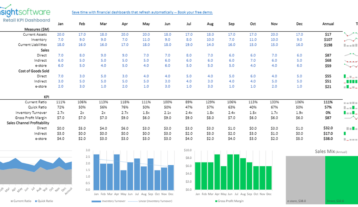Top Five Financial KPIs for Retail

The stakes are high in the retail industry. On one hand, some bricks-and-mortar retailers are fighting to remain relevant and overcome the strain of the coronavirus pandemic. On the other hand, online retail is surging, leading to fierce competition and tight profit margins. Retailers have new sales channels at their disposal and many opportunities to innovate and disrupt, but they’re also facing pressures to adapt faster than seems possible. Some retailers will thrive in this climate, while others will struggle.
Remaining in the first camp requires many things: fresh ideas, new concepts, different inventory, a bigger digital footprint, and more. Most importantly, retailers hoping to thrive in turbulent times need a keen financial focus. Fiscal mistakes can sink an otherwise promising retailer or compromise a transformation, whereas good financial management can propel a retailer to take the right risks at the right time.
Financial management begins and ends with KPIs. Their present position reveals what needs to be done, and their future position proves whether that effort worked. Think of financial KPIs as the vital signs of your organization. It’s obvious they need close and consistent tracking. Less obvious are the specific metrics that bring financial performance into focus. Here are five KPIs that deserve your attention:
1. Current Ratio
Expressed as the current assets over the current liabilities, the current ratio is the king of financial KPIs because it reveals a retailer’s liquidity or ability to cover short-term expenditures. Cash flow issues are the number one business killer, which is why companies need to watch for warning signs. Monitoring means knowing where the current ratio sits at all times and how it’s trending historically.
2. Quick Ratio
Think of this as the cousin of the current ratio. The formula is the same (assets over liability), except that the current ratio excludes inventory from the assets category. Why? Because it may be hard to sell inventory quickly or for full price, making this asset less liquid than cash. However, inventory does have value and can’t be excluded from the liquidity equation. That explains why it’s important to track both the current and quick ratios.
3. Inventory Turnover
Also illustrative of cash flow and overall financial strength, inventory turnover tracks how quickly goods are sold through all channels. Calculate the inventory ratio by dividing the cost of goods sold (COGS) by the average inventory on hand. Decision-makers can gain extra insight by also examining the average days to sell by dividing 365 by the inventory turnover.
4. Gross Profit and Margin
The previous metrics focused on short-term financial health. The gross profit and margin offer a longer-term look at how well a retailer can expect to do. Estimate gross profit by subtracting COGS from net sales, and then calculate the profit margin by dividing gross profit by sales revenue. Declining figures for either metric could indicate it’s time to raise prices or rein in operating costs.
5. Sales Channel Profitability
In today’s omnichannel retail environments, merchants need to track how profitable they are across each sales channel (online, in-store, mobile, hybrid, etc.). For each channel, take the gross revenue and subtract the direct COGS and the direct expenses involved. Watching how the various channels perform can help a retailer fine-tune its marketing and product mix to bolster lagging channels.
Knowing what retail financial KPIs to track leads to the bigger question of how to get the constituent data as quickly and accurately as smart financial decision-making requires. insightsoftware exists to answer that question. As leaders and innovators in the field of purpose-built reporting solutions, we make data accessible and insightful. Learn what all you could do with the right metrics at your disposal. Download our Ebook: Guide to the Right KPIs for the Modern CFO.



